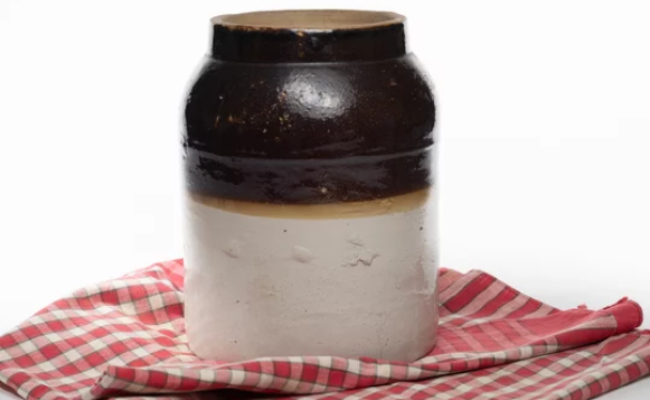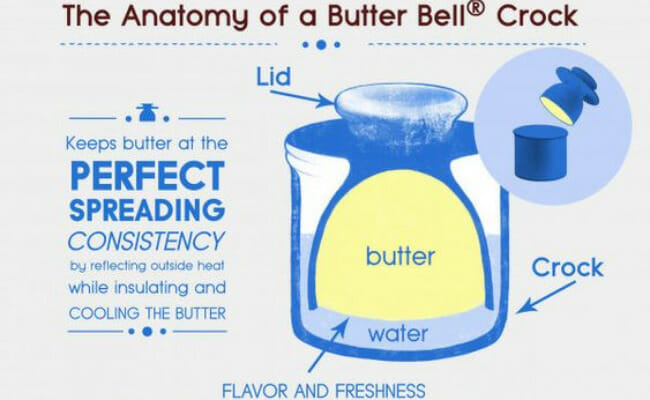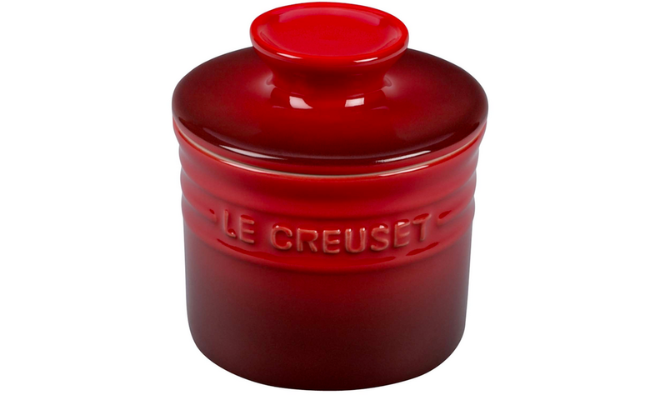What’s a Butter Bell and Why Do You Need One?
It can be pretty annoying when your toast shreds apart because of how cold and hard the butter is. A simple thing like not remembering to soften it can ruin a good morning.
Like most people, taking your butter out of the fridge may not be the first thing on your mind as you wake up. Though you can easily throw it into the microwave, that can be inconvenient.
You may leave a stick outside the fridge the night before, but it might go bad due to the exposure to air and warmth. Luckily, there’s a much easier way to simultaneously keep your butter soft and safe. The butter bell is an invention that allows you to keep it right on your table and available for use.
What is a Butter Bell?

Photo Credit: Adobe Stock
A butter bell is a clever piece of ceramic used for decades to preserve butter without refrigeration. It’s also referred to as a butter crock or butter keeper.
This item comes in two parts: a lid fitted with an upside-down bowl filled with butter and a bottom crock with water.
Believe it or not, the bell is not a recent invention. It’s said to have originated in France during the late 19th century. It was known as the French butter dish or the “Beurrier Breton,” as they called it.
L.Tremaine trademarked their version in 1995, calling it “The Original Butter Bell Crock.” It was famous among veteran home cooks who know the value of always having softened butter for their recipes. It gradually made its way to America through craft fairs.
Brief History of Butter Keepers
People initially stored their recipes in wooden containers. The first bells of ceramic material were designed and marketed in the city of Vallauris by famous French potters. These ceramic keepers grew popular because they were easier to clean than their wooden counterparts.
Between the 1970s and 1980s, American craft potters rediscovered this French butter crock and started producing these recipes for craft fairs and stores. These days, butter bells are a great way to keep soft and spreadable butter ready for your recipes.
Butter Keepers as Collectibles
Vintage keepers are now considered prized collector’s items. Americans, in particular, cherish these items because they stand for a time when there was no refrigeration, and families had to find a way to preserve their butter on the kitchen table.
Why should I use a Butter Bell?
The question is, why shouldn’t you? Do you always want soft butter that can quickly spread on your biscuits or pancakes? Or, would you rather leave your stick of butter refrigerated, hoping you won’t forget to take it out?
This old invention has been in use by Southern cooks for preservation since the middle ages. You don’t have to heat it or remember to remove it from the refrigerator before use. What could be easier than that?
How does a Butter Bell Work?

Photo Credit: Southern Living
At first glance, the shape can be confusing as it looks both easy to use and technical. The device has two parts: the crock and the lid. The lid has a cup attached. You slip your butter into this cup and then put cold water into the other.
Yes, water! It helps it to remain at room temperature and keeps it soft. You should know that you cannot just pick up this device and use it. You would need to have the proper tools.
How to Use Your Butter Bell
To use this tool properly, you’ll first need good butter. Using cheap stuff or margarine can make it even more difficult.
You’ll also need the correct water measurement. In a butter bell, less is more. You need just enough water for the top of the butter to form a seal when replaced. If you put too much water, you get wet butter. You may not have had it, but it does taste as terrible as it sounds.
The perfect measurement would be when the water nearly touches the butter. You would also need to replace the water weekly to ensure it doesn’t get too warm. Remember that the colder your water, the fresher your spreadable butter.
You would also need to consider the position of the bell. It would help if you didn’t place it under direct sunlight; otherwise, it would ruin its effect. The container gets too hot, and, you guessed it, the butter does not stay fresh.
Finally, you’ll want to pile up the butter in there. It would be best to put it well enough to eliminate all the air pockets. Otherwise, the pad would fall directly into the water when you open the lid.
Tips to Keep Your Butter Fresh
Taking care of your keeper is easy. Since the material of the dish is porcelain, it is long-lasting and dishwasher safe. In the past, crocks were considered family heirlooms. To ensure the best results:
1. Replace the water every three days.
2. Add a pinch of salt to the water.
3. Wash with soap and water (or a dishwasher) at least once every month.
4. Ensure it is dry before refilling. Otherwise, it may fall out of the bell.
Conclusion
You’re probably wondering how such a fantastic invention existed without you knowing all this time. With these keepers, you can spread butter easily at any time. Say goodbye to hard and cold spread in your toast.
A butter bell dish will keep its contents good for up to thirty days, making it readily available for any recipes you may need it for. It doesn’t hold much content, so chances are that you would finish it before the thirty days are up.
Frequently Asked Questions
Where can I buy butter crocks?
Keepers are still handcrafted, and several manufacturers produce them. L. Tremain (The Original Butter Bell) and La Creuset produce stoneware keepers with elegant designs in different colors. Norpo also produces cheaper keepers and has one made from marble.


